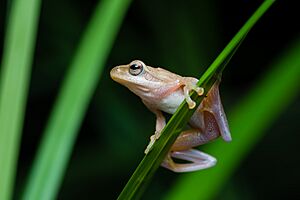Doria's Asian treefrog facts for kids
Quick facts for kids Doria's Asian treefrog |
|
|---|---|
 |
|
| A Doria's Asian treefrog at Phu Khiao Wildlife Sanctuary | |
| Conservation status | |
| Scientific classification | |
| Synonyms | |
|
The Chirixalus doriae, also known as Doria's Asian treefrog, is a type of frog that belongs to the family Rhacophoridae. You can find this small frog in many parts of southeastern Asia. Its home stretches from northeastern India and Bangladesh all the way to Myanmar, Thailand, Cambodia, Laos, Vietnam, and southern China.
Contents
What Does It Look Like?
This treefrog is quite small. Adult male frogs are about 25 to 27 millimeters long. That's about the length of a small paperclip! Female frogs are a bit bigger, measuring 29 to 34 millimeters. This measurement is taken from their nose to their bottom, called the snout-vent length.
The Doria's Asian treefrog has a pointy nose. Its skin on the back can be bright yellow or brown, often with brown stripes. The backs of its legs are purple, and some even have black stripes on these purple parts. You might also notice white areas on its neck. The underside of its back legs is red.
These frogs have special sticky pads, called disks, on their toes. These disks help them climb easily. Because of this, they are known as arboreal animals, meaning they live mostly in trees.
How It Makes Babies
When it's time to lay eggs, the female Doria's Asian treefrog looks for a permanent pond or stream. She creates a special "foam nest" on the underside of leaves that hang over the water. She lays her eggs inside this foamy nest. The baby frogs then develop from these eggs as larvae (like tadpoles) before they become adult frogs.
Where Did Its Name Come From?
The second part of the frog's scientific name, doriae, is a tribute to a person. It honors Giacomo Doria, who was an Italian zoologist. A zoologist is a scientist who studies animals.
Where It Lives and How It's Protected
Doria's Asian treefrogs usually live in forests where the trees form a thick roof, called a closed-canopy. They also live in grasslands. Sometimes, you can even spot them in rice fields or on plants near train tracks! These frogs can be found at different heights, from just 8 meters above sea level up to 1630 meters high.
The International Union for Conservation of Nature (IUCN) says this frog is of "least concern" for extinction. This is good news! It means there are many of them, and they live in a very wide area. Their homes include protected places like Phou Louey National Biodiversity Conservation Area in Laos and Lawachara National Park in Bangladesh.
However, there are still some threats to these frogs. Forests are sometimes cut down to make space for farms. This is especially true for cash crops like coffee, rubber, and tea. Losing their forest homes can be a problem for the Doria's Asian treefrog.


